11
Why cities?
Cities are a relatively recent part of human culture. The first settlements recognized as cities arose about 10,000 years ago in what is now considered the Middle East. While this region saw the first cities, cities also developed independently around the world in the millennia following, emerging from hearth areas of civilization. Why did cities come about during this time period? Different scholars will point to different reasons, but these three are commonly provided:
- Agriculture became efficient enough to create a productive surplus
- A growing population created pressure to densify
- New social organizations of power developed
Agriculture, the process of cultivating plants and/or livestock, is often given as a primary reason for the creation of cities. Once humans began to cultivate crops, humans became less migratory and built permanent structures so that they could tend to and store agricultural products. As humans improved agricultural methods, soon a single farmer or farming family could produce more food than they themselves needed for sustenance. The result is that within this permanently-located society, not everyone needed to be an agriculturalist. Instead, the productive surplus meant that people in the society could have more specialized, non-agricultural livelihoods; a more complex division of labor emerged. The specialization that took place meant that some people would grow and raise food for society, while others would build structures, create tools, defend the settlement as professional soldiers, or become philosophical/religious leaders. As agricultural production improved, more people had access to food leading to population increases. However, agricultural technology did not yet exist to improve marginal lands to productive lands. This meant that the increasing population needed to be more dense around productive lands, leading to denser settlements like cities. Lastly, most of these nascent urban societies, in creating a complex division of labor, moved away from egalitarian power structures and instead became more hierarchical, with a few at the top with much societal power and influence and many at the bottom with little power. Power often came to religious or military leaders. Organized power also enabled the society to collect taxes, pooling resources so that large, permanent structures were built. These structures, such as temples, themselves demonstrated the increased power of the society.
Spatial structures of cities
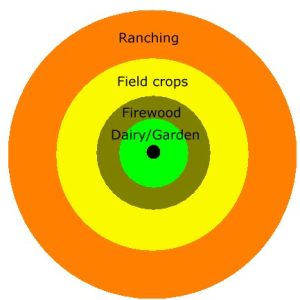
Before investigating how cities are internally structured, it is illustrative to view the von Thunen model of hinterland organization. In 1826, Johann Heinrich von Thunen created an economic model of how the area around the city from which resources are gathered (the hinterland) is organized. Two key points of this economic model become analogous for economic rationale for how cities are theorized to organize. First, this model showed that proximity to the city came with a premium on price due to desirability. This meant that land uses nearest to the city had to be the most profitable in order to afford land rent. Second, the resulting organization of the hinterland is in concentric rings, with more profitable products closer and less profitable products further from the center. As an economic model, these outcomes are contingent upon several assumptions, none of which are truly realistic. However, it models an idealized form that is altered and complicated by the complexity of local and regional geographies in all locations. The assumptions are:
- The City is in the center of an isolated State; it is a single market
- The hinterland itself is surrounded by “wilderness”; combined with the prior assumption, it means that there are no connections or products coming to this region or being exported out of the region
- Land is ubiquitous; there are no differences in soil type, topography, or climate, and no water features. All environmental factors are equal everywhere
- Farmers transport their own products to market using an ox cart without roads; roads change the ubiquity of land and therefore don’t exist
- Farmers behave rationally in order to maximize profits; farmers seek the most profitable use of their land
Given these assumptions, von Thunen predicted that certain types of production (or land use) would dominate certain rings. The inner-most ring would be dedicated to dairy production and market gardening. Both categories of agriculture are bulky to transport, can potentially spoil quickly (this is before the invention of refrigeration), and have relatively high productivity per acre in terms of sale price. As such, farmers both can afford the more expensive land, and need proximity in order to get products to market. The next ring is wood for fuel. As with dairy/gardening, it is bulky and hard to transport, but does not produce as much value per acre, therefore it occupies less expensive land. Following fuel wood is a ring of grains and field crops. This produce needs many acres, but cannot merit a large market value per acre planted. Grains however store well and do not need to come to market immediately after ripening. Farmers therefore need larger quantities of cheaper land, and are willing to travel further to market due to a lack of immediate spoilage. The last ring is ranching and livestock. Livestock is transported easily to market, so proximity is not necessary. As well, though an individual cut of meat may be more expensive than the products mention above, meat production is the least profitable per acre. It may take years to raise livestock to the proper age for butchering and it takes vast amounts of grazing land for the larger animals. For these reasons, ranching is furthest from the market and the last agricultural ring before wilderness.
When it comes to cities, similar economic models are used to look at basic spatial structural patterns. A land value model of urban land uses is one such example. In this model, land values are estimated based on bid rent. Bid rent is the amount of money an individual parcel of land can receive for any land use. While true bid rents are based on a function of site and situation (attributes of the parcel itself and its location/accessibility), the land value model simplifies reality through these assumptions:
- There exists a prime value intersection (PVI); the central point of a city with the highest amount of access
- Access from all other places to the PVI is based solely on distance; no transportation network effects
- All sites are ubiquitous; site advantages like hills, ocean views, and others do not exist
- There is no zoning or planning for particular land uses; land use is based on market forces only
With these assumptions, we get the formula:
Bid Rent = Land Value at PVI – Access Costs
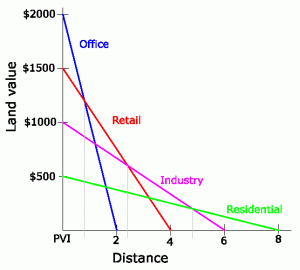
Different land uses have different attenuating effects of distance. In other words, some land uses must have high access, and others can have further distance from the PVI and still be profitable. Land uses have different bid rent curves, or different slopes, affected by accessibility. The image to the left is a rough demonstration of this concept. In this simplified model, there are four land uses: office, retail, industry, and residential. Each has a different bid rent curve on the basis of access costs. Office space, where corporate headquarters locate, need access and connectivity, and are also quite profitable. The office bid rent curve then is the steepest; office land uses are willing to pay a premium for the most access, and are unwilling to pay if access decreases too much. Retail likewise wants access, for walk-in shoppers and increased customer traffic, but while profitable are not as profitable as office space. Retail land uses then won’t pay the extreme premium of office space, and is willing to have slightly less access. Industry also desires centrality, but generally needs more parcel space than is affordable near the PVI. Industrial land uses are less profitable and need lower rents that have less accessibility. Residential uses have the lowest profitability but also have little stake in needing prime access, and have the shallowest bid rent curve.
As a result, whichever land use is willing to pay the most at each location becomes the land use of that location. This is the “highest and best use” of the land. The result are rings of development based on distance. The gray lines on the image show the distance break points when one dominant land use cedes to another that is willing to pay the highest rent. The center ring is office, then retail, then industry, then residential. At a certain distance, residential land uses too are far from the PVI that rent could be $0 and residences still won’t be built. Think of it this way; if someone offered you a free house, but it was 500 miles from your work or school, you probably wouldn’t live there! The access costs of commuting would be too great.
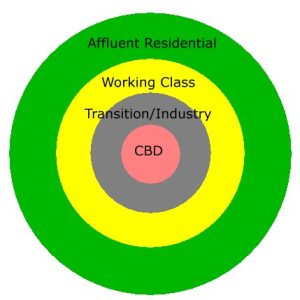
The Burgess concentric ring model is, in many ways, seemingly similar to the land value model outlined above, but with one major difference; the land value model is economic in nature, and the Burgess model is social. The Burgess model outlines rings of zones based on creating social distance between different groups of people. The inner-most ring is the Central Business District (CBD), where offices, public-facing government buildings, major institutions of culture (EG: museums), and retail are situated. Surrounding that core is a zone of transition that includes industry and factories. The last rings are residential, with the working class occupying land closest to factories and the more affluent classes (middle and upper class) living furthest away. While Burgess did see that the residential land uses where stratified by income, the rationale was still social in nature. The wealthy were living further away to avoid the dirt and noise of the city. Their ability to do so was of course due to economic advantages, like being able to afford transportation and larger plots of land, but the Burgess models the choice as being one to create social distance and not the “highest and best use” of land.
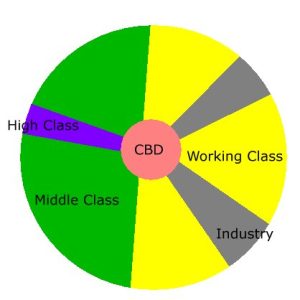
The Hoyt sector model adapted Burgess to show how cities do not stay in neat circles, but instead have expanding zones of development that often hug transportation corridors. Cities may have sectors of industry that follow a railroad, highway, or body of water, sited so as to lower transportation costs of goods. Small and large cities alike have a ‘main drag’ of businesses and retail that follow major surface roads. Sometimes the most fashionable neighborhoods of a city generally expand out corridors; these neighborhoods are sometimes nicknamed a “Millionaire Mile” in the city, indicating its sector-based alignment. The Hoyt model still shows that residential uses are largely segregated by socioeconomic class.
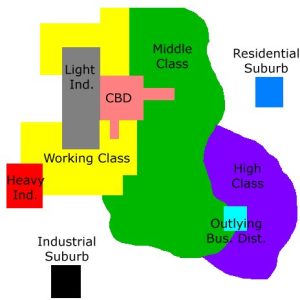
A third common model discussed is the Harris and Ullman multiple nuclei model. This model starts with the central business district of the other models, but shows that a newer and smaller CBD develops on the outskirts of the city. This newer CBD takes advantage of shorter commuting distance for the more affluent people living in the residential areas far from the city center. As well, the multiple nuclei model shows the effect of transportation hubs, like ports or airports, on settlement patterns. Overall, the multiple nuclei model is adapting towards American cities becoming automobile dominant and much more suburban in nature.
It is important to note about these models that they are largely based upon cities of the developed world, particularly in North America. Concentric rings was based upon Chicago in the early 20th century, while the multiple nuclei model was based upon Los Angeles at the beginning of the massive suburban exodus that would become dominant in North American cities.
Exercise: Slums
Slums are areas within or adjacent to an urban center occupied by people with no-very low income who live in precarious infrastructure vulnerable to damage or collapse from heavy winds, rains, mudslides, and other hazards. Structures in slums are often not hooked up to public services like running water or electricity. People living in slums often participate in the informal economy, which is comprised of jobs without benefits nor subject to labor laws and minimum wages. See below for more information.
- Slums in Latin America are called favelas (Brazil) and barrios (Venezuela). Check out this video about favela tourism. What’s YOUR take on favela tourism? Who does it benefit, at whose expense, and who does it harm?
- Makoko is a floating slum in Lagos, Nigeria. Why is there an effort to map Makoko? What opportunities and/or risks come with being mapped?
Suburbanization
Between the urban core and the rural hinterland, serving as a kind of buffer and transition zone between the two, are suburbs or suburban spaces. The suburbs are primarily residential but also have public services like schools and businesses people need to rely on to go about their daily lives. Plenty of people live and work in the suburbs, but commuting to work in or nearer the urban center and living in the suburbs is the predominant pattern. Sprawl refers to the expansion of suburbs without a population to match; in other words, infrastructure is built, electrical lines are put up, but the space is not yet occupied with people. If you have ever driven through a neighborhood with brand new houses, usually looking pretty similar to each other (having standardized housing allows for it to go up quickly and can be cheaper to purchase) but only a handful seem to be occupied, you’ve likely witnessed sprawl. An obvious critique of sprawling suburbs is the extreme consumption of land through this development pattern. Regions with modest or even negative population growth are still growing in terms of the footprint of development; a process which often destroys natural landscapes like forests and wetlands, and working landscapes like farms. The wildland-urban interface (WUI) refers to where human settlement meets unsettled and undeveloped spaces. Research shows that that expansion of settlement into the WUI, which provides residents with a beautiful residential setting, intermingled with more or less in-tact natural surroundings, increases risk for wildfire exposure because settlement is encroaching in “wild” spaces that experience natural fires. Another geographical critique of sprawl is that this development pattern often lacks a sense of place, or a uniqueness of feeling people attach to place. Remote sensing helps assess and measure sprawl, as evidenced in the video below.
The 1950s and 1960s in the United States are classically considered major periods of suburban development. This was in part due to changes in transportation which made it possible to more easily commute in and out of the city center, the culture of consumerism, and also because it was during the post-war era when families were reunited and expanding, and the government had programs incentivizing the construction and selling of houses for veterans. The creation of the Interstate system in particular changed the paradigm of commuting over long distances. Interstates not only connected major cities to each other, but cut through many cities themselves. As a result, suburbanites could live dozens of miles from the center of the city, but still commute via personal automobile in a reasonable time frame.
One such effort can be seen in Levittown, a planned community in Pennsylvania which had cookie-cutter houses specifically built for veterans. The video below shows historical footage of a house going up in a day in Levittown. What the video leaves out is the fact that this particular suburban project, and many others, contributed to residential segregation, a relic with which suburban spaces of today have to contend and reverse. During the early days of suburbanization, only those that could afford home and auto ownership could live in the suburbs, leading to socioeconomic segregation. While some suburbs maintain this separation of affluence, many suburbs now are places in which those of moderate incomes can live. The link in the grey box above discusses this further.
Two additional patterns of suburban development are notable. First are new development patterns called exurbs. Exurbs are residential, prosperous, but rural areas beyond the suburbs. In the United States, the Census Bureau defines areas as either urban or rural mostly on the basis of population density. There is no definition for suburbs or exurbs at the federal government level. Generally, most suburbs maintain a high enough population density (roughly 1000 people per square mile or more) that the Census Bureau categorizes them as ‘urban’. But, there are large swaths of land within commuting distance of cities that are defined as rural; in fact, the majority of land inside metropolitan areas is actually rural. This does not mean agricultural, however; there are many that live lifestyles quite connected to the nearby urban core but live in low population regions in the metropolitan area. These areas are the exurbs and the people are exurbanites. A major way of distinguishing between exurban areas and what we colloquially think of as rural is to understand the development pattern and the people occupying the space. Exurbs are generally affluent, shown by statistics on income levels or observing the large footprints of houses. Exurbanites are largely still connected to urban living via commuting and culture.
A second pattern is that of edge cities. Edge cities are new concentrations of business, retail, and residences outside of the urban core. They are so named edge cities as they are located on the edge of the traditionally denser development of a major city, but edge cities themselves are starting to be centers in their own right. The classic example of an edge city is Tyson’s Corner in Northern Virginia. Edge cities are distinguishable from the surrounding suburbia by possessing development density (as viewed through taller buildings) and the presence of service/retail and office employment. However, edge cities do not have the density of ‘traditional’ urban cores. Other ways in which edge cities are unique compared to traditional cities are that edge cities:
- Are often unincorporated, meaning they lack municipal borders and local government
- Tend to have spread out, car-centric development
- Are often sited at the junctions between highways and expressways
Emphasizing the first point above, most edge cities are not legally-defined cities!
Edge cities developed in three waves. First, there was suburbanization of the population. People moved from the urban core into suburban developments. Second, retail suburbanized in new developments called malls. This ‘malling of America’ brought retail from the urban core to locations closer to the stores’ affluent customer base. Third, companies and industry moved to these areas. White collar employers found cheaper land to build headquarters or to otherwise expand their business footprint within the region. As the third point above details, malls and employers tended to concentrate near junctions of large roads, facilitating the personal automobile as the primary means of transportation into these new centers.
Urban systems
Cities are connected, interrelated, and distributed in knowable ways. Cities organize according to an urban hierarchy, which how an urban system distributes cities on the basis of size and services. Urban settlements are central places; places in which goods and services are available for purchase. The more central a place is, more goods and services are available. Goods and services also have a range, which is the distance a customer is willing to travel to consume the good or service.
These interrelated concepts were placed together by Walter Christaller in 1933 as Central Place Theory. Small settlements like towns, villages, or hamlets have limited centrality and only provide goods and services with shorter range. These places provide for the people in the immediate area, such as those living in the hinterland. Larger settlements provide more goods and services, and some of those goods and services have a larger range, pulling customers from further away. These longer range goods and services may be those that are more expensive or of infrequent use. The result geographically is an urban system in which there are many smaller-sized places surrounding a few large, somewhat far apart large areas.
You as a reader have likely experienced this concept without knowing the theory behind it! If you are home, and notice that you are out of milk, you are probably going to walk or drive to a shop less than 10 minutes away. Likewise, people do not travel hundreds of miles in order to purchase gasoline for a car. These are goods that have a short range, and therefore we see lots of small settlements, fairly close together, in order to provide people with daily goods. On the other end of the spectrum, major professional sports, operas, and other cultural services are only found, with few exceptions, in the largest of cities. Customers are often willing to travel long spatial and temporal distances for these services. The same pattern is seen when looking at a single good. The types of automobiles available for purchase follow a similar pattern. Small settlements may have used car lots with inexpensive cars. Somewhat larger places will have dealerships for mainline or common makes like Ford and Honda. In even larger/more central places, higher-end brands like BMW and Lexus emerge. And, in only a few major cities are you likely to find the most luxurious brands like Bentley and Lamborghini. One is unlikely to find a Tesla storefront in a tiny village!
Like the geo-economic models outlined above, Central Place Theory depends on assumptions of ideal conditions. If the ground is featureless and ubiquitous, and if transportation is equal in all places, the hierarchy of central places will be hexagonal in shape. The largest cities will be in a hexagonal pattern, with mid-sized cities arranged around each in a hexagon, with smaller cities around each of those in a hexagon, and so on down to the smallest settlements.
The urban hierarchy goes even higher than a region or a country; there are global cities. Global cities are cities that are influential in the worldwide economic system. These cities host a disproportionate amount of the world’s most important business, culture, and politics. In other words, these are centers of power that have a strong influence over things that occur around the world. These are often, but not always, the largest cities. In some cases, there are large population cities that do not have a strong global influence; these are common in the Global South or developing world. While global cities are more often discussed for overall economic impact, one can also describe global cities in various economic sectors. For example, Milan is not one of the largest cities, but is globally important as a “fashion capital.” The definition for global cities is loose, but commonly cities that have large, important financial sectors are included; think of cities like New York, London, Tokyo, and Shanghai with large stock exchanges.
The largest cities are called megacities. These are extremely large cities, typically with 10 million people or greater, that are highly centralized and have the highest population in their state. One can also use the term megaregion as these are metropolitan regions that include developed land both inside and outside the city proper.
Media Attributions
- VT
- bidrent
- CR
- HS
- MN
areas of earliest urbanization
the process of cultivating plants and/or livestock
food needed to sustain self
food produced beyond sustenance
complex division of labor
clustered
equal
structure of power with set of leaders at the top
model of urban structure based
rural area surrounding urban center
bands of activity
model of urban use
amount of money an individual parcel of land can receive for any land us
attributes of the land parcel itself
surrounding areas and location/accessibility of land parcel
the central point of a city with the highest amount of access
how land use is affected by accessibility
urban structure model based on creating social distance between different groups of people
concentration of business in core of city
urban structure model that identifies expanding zones of development that often hug transportation corridors
urban structure model that asserts a newer and smaller CBD develops on the outskirts of the city
in between urban and rural
are areas within or adjacent to an urban center occupied by people with no-very low income who live in precarious infrastructure
activities that happen outside of any formal regulations
regional name for slum in Brazil
regional name for slum in Venezuela
buffer between urban and rural
areas marked by the suburban form
xpansion of suburbs without a population to match
unifrom
where human settlement meets unsettled and undeveloped space
uniqueness of feeling people attach to place
collecting data from afar
separation of residences based on demographic traits
residential, prosperous, but rural areas beyond the suburbs
people who live in exurbs
new concentrations of business, retail, and residences outside of the urban core
lacks municipal borders and local government
how an urban system distributes cities on the basis of size and services
places in which goods and services are available for purchase
distance a customer is willing to travel to consume the good or service
theory on urban settlement that says urbanization results in many smaller-sized places surrounding a few large, somewhat far apart large areas
cities that are influential in the worldwide economic system
extremely large cities, typically with 10 million people or greater
